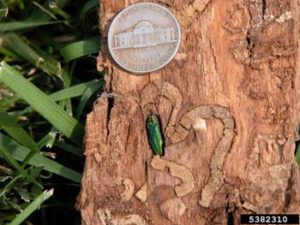Tree Removal
Per City Code Section 151.03 – Duty to trim trees. If the abutting property owner fails to trim the trees, the City shall serve notice for action to be taken within five (5) days. And if it is not taken in that time, the City may perform the work and assess the property owner.
Per City Code Section 151.06 – Inspection and Removal, the City shall inspect any dead, diseased or damaged trees. Those on City property may be treated or removed. If it is determined that any tree on private property is dangerous to other property or passing motorists, the City shall notify the property owner for action to be taken within fourteen (14) days. And if it is not taken in that time, the City may perform the work and assess the property owner.
Emerald Ash Borer
The Iowa Department of Natural Resources has confirmed Emerald Ash Borer in several counties around the state and suggested communities think about how they can deal with this invasive pest. Nevada has 365 ash trees in the City right-of -way, in City parks, or at City-owned facilities. To be proactive in dealing with this destructive insect, city leaders have decided to go ahead with a plan to remove and replace these trees.
What is Emerald Ash Borer and why is it a problem?
Emerald Ash Borer or EAB, is a small metallic green beetle native to Asia. Adult beetles are about 1/2 inch long x 1/8 inch wide or about the size of Abraham Lincoln’s head on a penny. They likely came over from Asia around 2002 in wood shipping pallets and had spread throughout the country since then.
Adult beetles eat ash foliage causing little damage to the tree. The EAB larvae grow and feed on the plant tissue under the bark of the ash tree. The tunneling caused by the larvae prevents water and nutrient delivery which deteriorates the health of the tree. This can ultimately lead to the tree’s death. Affected trees of the genus Fraxinus including: Green, White, Black, Blue, and Pumpkin ash but NOT Mountain ash (Sorbus species).
A picture showing the size of an adult Emerald Ash Borer as well as larvae tunnels can be seen below.
Where can I find more information about Emerald Ash Borer?
The Iowa State University Extension and Outreach Office provides extensive information and videos on the ISU extension EAB website. Our professional tree consultant, Copper Tree Consulting, also suggests Purdue’s EAB website for further information.
Some other helpful links regarding ash tree identification and EAB include:
What is the City's plan in dealing with Emerald Ash Borer?
The City has been removing all ash trees that fall within the City’s Right of Way.
Are there any suggestions for how I can help deal with Emerald Ash Borer?
There are a couple ways you can help deal with the emerald ash borer problem. According to the Iowa DNR, EAB spread has been primarily caused by the movement of firewood. The DNR has enacted a quarantine for all 99 counties in Iowa meaning that citizens should not move firewood across state or county lines.
Identifying ash trees on your property and watching for signs of decline can help as well. Signs of decline can include:
- Top of the tree thinning or dying off
- Spindly sprouts (water sprouts or “suckers”) growing from the trunk or roots
- “D” shaped exit holes (1/8 inch diameter)
- Increased woodpecker activity
- Feeding notches on edge of leaflets
- “S” shaped feeding galleries under dead bark (as seen in picture above)
I have an ash tree in my back yard I am concerned about, what can I do?
If you have an ash tree on private property that you are concerned about, you may wish to contact the local extension office or a professional tree service to discuss options for treating, removing, or replacing your ash tree.
If you suspect your tree may have Emerald Ash Borer, you can contact one of the following:
- State Entomologist Office, IDALS: 515-725-1465
- Iowa DNR Forestry, 515-281-4915
- Iowa State Extension Outreach, 515-294-1101
Planting Trees in the City's Right Of Way
Following the loss of so many trees in our community to severe storms and Emerald Ash Borer, in 2024, the City of Nevada established the following allowance for planting trees in the Right Of Way.
Eight tree types will be allowed to be planted in the ROW:
- Kentucky Coffeetree
- Presidential Gold Ginkgo
- Hackberry
- American Boulevard Linden
- Exclamation London Planetree
- Pink Sparkles Crabapple
- Autumn Brilliance Serviceberry
- Redbud (single)
Before planting any tree in the City ROW, a property owner must go through the Iowa One Call (811) process and follow all guidelines for staying clear of any utilities when planting.







